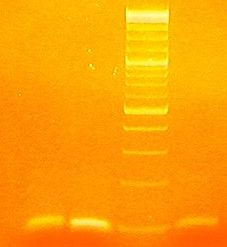Team:Bologna/Lab-Notebook
From 2009.igem.org
(Difference between revisions)
Marco.cavina (Talk | contribs) |
(→Week 7: from 08/31/09 to 08/4/09) |
||
| Line 127: | Line 127: | ||
[https://2009.igem.org/Team:Bologna/Lab-Notebook ''Up''] | [https://2009.igem.org/Team:Bologna/Lab-Notebook ''Up''] | ||
| - | =Week 7: from 08/31/09 to | + | =Week 7: from 08/31/09 to 09/04/09= |
* Done some experiments (trasformation and digestion with the same plasmid, PSB1A2, using different concentration of annealed) to confirm the Gfp contamination. All the gel runs have a 1000 bp strand. | * Done some experiments (trasformation and digestion with the same plasmid, PSB1A2, using different concentration of annealed) to confirm the Gfp contamination. All the gel runs have a 1000 bp strand. | ||
Revision as of 08:29, 28 September 2009
| HOME | TEAM | PROJECT | MODELING | WETLAB | LAB-NOTEBOOK | DRY LAB | SUBMITTED PARTS | HUMAN PRACTICE |
|---|
Contents |
Week 1: from 07/20/09 to 07/24/09
- Trasfomation of PSB1K3, PSB3K3, PSB1A2, PSB4A3(2007). Only the last one seems to work. We also use PSB1A2.
- Trasformation and Amplification of A, B, C:
A) PSB3K3(LMC) + 1429 + RBS + LACI
B) PSB1A2(HC) + 2547 + Ox + RBS + GFP + T
C) PSB3K3(LMC) + 1429 + RBS + GFP + T
- Working (using DH5alfa) on:
A + B ---> Evaluation GFP fluorescence imaging comparing with the rRBS one
B ---> Evaluation GFP fluorescence imaging
C ---> Evaluation GFP fluorescence imaging
B+C ---> Evaluation ΣGFP fluorescence imaging
Week 2: from 07/27/09 to 07/31/09
- Sequences suspension to have 100 μM conc. (EP digestion and trasformation in a HCN plasmid with AMP)
| DNA sequences | Plasmid |
|---|---|
| H2O mQ == 4.5 μM | H2O mQ == 19.5 μM |
| Sequence == 20 μM | DNA (miniprep) == 5 μM |
| Buffer == 3 μM | Buffer == 3 μM |
| BSA == 0.5 μM | BSA == 0.5 μM |
| EcoRI enzyme == 1 μM | EcoRI enzyme == 1 μM |
| Pst1 enzyme == 1 μM | Pst1 enzyme == 1 μM |
| TOT: 30 μM | TOT: 30 μM |
Gel Run:
1.CIS
2.TRANS 4
3.MARKER
4.TRANS 7
5.PSB1A2
Week 3: from 08/3/09 to 08/7/09
- Amplification of CIS, TRANS 4 and TRANS 7 using PSB1A2. Inoculation and digestion.
- Unexpeted results from the gel run in all three sequences (3000, 2200, 1000 bp instead of 2100, 2000, 100 bp):
- Done the ligation again whit the same bad results.
- Done some test fluorescence measurements using GFP in plasmids with different copy number.
Week 4: from 08/10/09 to 08/14/09
HOLIDAY!!!
Week 5: from 08/17/09 to 08/21/09
- Done again the amplifications of CIS, TRANS 4 and TRANS 7 using PSB1A2 to undestand which is the problem we have had during the third week. Achieved the same wrong results.
- We decided to sequence the 1000 bp strand to understand what it really is. We sent our material to the Bmr-genomics in Padova for the dna sequencing.
Week 6: from 08/24/09 to 08/28/09
Bad news for our team:
- Re-Annealing of our sequences and after have done the PRC-Colony we discovered that the colonies were green. Probably due to a GFP contamination. The DNA sequencing coming from Padova confirmed our theory: in the 1000 bp strand there was the presence of GFP protein and no sign of our CIS or Trans sequences.
Week 7: from 08/31/09 to 09/04/09
- Done some experiments (trasformation and digestion with the same plasmid, PSB1A2, using different concentration of annealed) to confirm the Gfp contamination. All the gel runs have a 1000 bp strand.
- Investigation to discover where is the contamination.
- Starting use a new plasmid: PSB4A3. Trasfomation and digestion with the CIS sequence. From the gel run came out a 400 bp insert that could be correct (CIS+Primer=100bp+270bp=370bp):
- The same attempt with TRANS 4 and TRANS 7 didn't give us any concrete resulst.
 "
"



